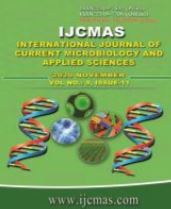


 National Academy of Agricultural Sciences (NAAS)
National Academy of Agricultural Sciences (NAAS)

|
PRINT ISSN : 2319-7692
Online ISSN : 2319-7706 Issues : 12 per year Publisher : Excellent Publishers Email : editorijcmas@gmail.com / submit@ijcmas.com Editor-in-chief: Dr.M.Prakash Index Copernicus ICV 2018: 95.39 NAAS RATING 2020: 5.38 |
Oyster mushroom is well known for its culinary properties and broad adaptability under varied agro-climatic conditions. Representatives of genus Pleurotus form a heterogeneous group of edible species of high commercial importance. However, there are many problems in taxonomy of Pleurotus spp. which are still unresolved. The concept of naming species on the basis of morphological characteristics has been dominant in the fungal taxonomy. However, morphological features of higher fungi are inconsistent as they are strongly influenced by cultivation substrate and environmental conditions. Consequently, different taxonomists have given different concepts and conclusions for the same taxon on the basis of morphological features. Molecular markers being enormous in number have a property of not being affected by the environment; make them a useful tool for understanding phylogenetic relationships as well as taxonomic identification. Mushroom is a macro fungus with a distinctive fruiting body which can be either epigeous or hypogenous and large enough to be seen with naked eye and to be picked by hand. The diverse climatic condition in India made this country a natural habitat for many mushrooms. The oyster mushroom (Pleurotus spp.) is highly suitable for commercial cultivation in subtropical regions of the world. They occur seasonally all over the world in various habitats such as humus rich soils, decaying plant litter and wood logs in forests as well as in meadows. The current study deals with “Molecular diversity among wild edible oyster mushroom (Pleurotus spp.) from western ghat of Maharashtra.” It includes the collection of isolates from AICRP on mushroom, college of Agriculture Pune. The major part of the investigation was the molecular characterization. In molecular characterization, Inter Simple Sequence Repeat markers were used to determine the genetic diversity among Pleurotus isolates. Under ISSR analysis, out of 50 primers screened, UBC-807, UBC-808, UBC-809, UBC-817, UBC-825, UBC-827, UBC-830, UBC-835, UBC-841 showed polymorphism and were selected for amplification. Cluster analysis of scorable ISSR bands generated a dendrogram revealing high genetic diversity in Pleurotus isolates and categorized 11 isolates into two clusters using 62 per cent similarity as a cut-off point. The average PIC value for the nine ISSR markers was obtained as 0.92. Results showed that primers namely UBC-809, UBC-817, UBC-825, UBC-827 and UBC-835 have above average PIC value and were to be more informative.
 |
 |
 |
 |
 |